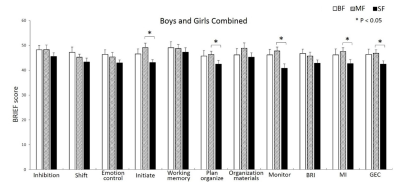Ting Li1,2, Thomas M Badger3, Betty Jayne Bellando3, Seth Sorensen3, and Xiawei Ou1,3,4
1Arkansas Children's Research Institute, LITTLE ROCK, AR, United States, 2University of Arkansas at Little Rock, LITTLE ROCK, AR, United States, 3University of Arkansas for Medical Sciences, LITTLE ROCK, AR, United States, 4Arkansas Children's Nutrition Center, LITTLE ROCK, AR, United States
Synopsis
While it is known
that breastfeeding promotes healthy brain development in children, the comparative
effects of formulas feeding substantially differing in composition (i.e.,
milk-based vs. soy-based) on brain development are unclear. In this study, we
recruited healthy 8-year-old children who were predominately breastfed, cow’s
milk formula fed, or soy-based formula fed during infancy, and evaluated their
brain cortical development using MRI. We also assessed their executive functions
using parental-reported Behavior Rating Inventory of Executive Function (BRIEF)
assessment. Differences in cortical thickness in multiple brain regions and
differences in BRIEF scores were both observed for children in different infant
diet groups.
Introduction
The most recent
Center for Disease Control and Prevention Breastfeeding Report Card shows that
currently 83.2% born in the US started out breastfeeding, and 46.9% were
exclusively breastfed at 3 months. For those who did not start out breastfeeding
or ended sooner than recommended, cow’s milk protein-based formula has been the
main alternative. In addition, soy protein-based formula
currently also accounts for a small percentage of the infant formula market in
the US and remains useful for infants allergic to milk formula or for parents
wishing to maintain a vegetarian lifestyle. While soy-based formula and
milk-based formula sold in the US all meet specific requirements of the FDA for
nutrient content, a major difference in soy formula and all other formulas is
that the soy protein used in soy-based formula contains isoflavones which can
have weak estrogenic activity, and this has led to some health professionals to
be concerned about sexual development and reproduction in children fed soy
formula. Many studies have
observed benefits to children’s health and development associated with
breastfeeding. Few studies have evaluated whether there are brain developmental
differences associated with soy- vs. milk- based formula, despite recent
findings that estrogen may play an important role in neurodevelopment and soy
isoflavone may have important implications in cognitive function. In this
study, we aim to evaluate whether different types of infant formula feeding
(particularly soy vs. milk based formula) during the first year of life would
have impact on children’s brain development and neurodevelopmental outcomes
such as executive functions. Methods
Healthy 8-year-old
children were recruited for this imaging
study. Inclusion criteria for the participants were:
age 90-101 months at time of study, parental report of an uncomplicated
full-term gestation, birth weight between 5-95th percentile-for-age
(5.5-9.25 pounds), and the type of infant diet between birth and age 8 months. They
were either predominately breast-fed (BF) or predominately fed commercially
available milk formula (MF) or soy formula (SF) during infancy. BF children
were breastfed for about 8 months or longer before completely transitioning to
formula and/or other diets. MF and SF children were fed the same types of
formula (cow’s milk-based or soy-based) since first weeks of life through age ~8
months or above. Exclusion criteria
for the participants included: maternal use of alcohol, tobacco, illicit drugs,
or psychotropic medications during pregnancy; illnesses and chronic diseases
which may affect children’s growth or development; psychological/psychiatric diagnoses;
neurological impairment or injury; history or current use of anticonvulsant,
stimulant, or mood-stabilizing medications; and history or current use of
remedial special education services. The children were scanned on a 1.5T
Achieva scanner (Philips Healthcare, Best, the Netherlands) with an 8-channel
SENSE head coil. Pulse sequences included a T1-weighted 3D turbo field echo
pulse sequence with the following parameters: 7.3 ms TR; 3.4 ms TE; 8° flip
angle; 1x1x1 mm acquisition voxel size; 256x232x150 matrix size; and 2
averages. The 3D T1 images were exported to a workstation with FreeSurfer software (developed by the Laboratory
for Computational Neuroimaging, Athinoula
A. Martinos Center for Biomedical Imaging,
Massachusetts General Hospital) for cortical thickness analysis. Standard
preprocessing steps were applied, and thickness for all cortical regions was calculated from distances between
gray/white to gray/CSF boundaries. In addition, the parents of the children
were asked to complete a Behavior Rating Inventory of Executive Function
(BRIEF) assessment, which is an
86-item questionnaire for parents that assesses executive function and
behaviors of their children. The MRI parameters and BRIEF scores were then
compared between different infant diet groups. In total, 71 children (10 boys /
12 girls for BF, 10/15 for MF, and 11/13 for SF) had valid structural MRI data
and completed BRIEF assessment and were included in this study.Results
A Number of clusters in the brain showed significant
differences in cortical thickness between the 3 diet groups. The details are
listed in Figure 1. The
three groups of children also showed significant differences in the measures of
parental reported executive functions using the BRIEF (Figure 2). In general, while the means of each score for each
groups are all within normal range, the SF group has lower BRIEF scores
(P<0.05) compared to the MF groups, for several subscales including
Initiate, Plan/Organize, and Monitor, and for combined measures including the
metacognition index (MI) and Global Executive Composite (GEC).Conclusions
Differences in brain
development, particularly, cortical thickness in several regions, were observed
in 8-year-old children who were predominately breastfed, cow’s milk formula
fed, or soy formula fed during infancy. These children also showed differences
in evaluation of parental-reported executive functions. Increasing group sizes and refining our analytical methods are currently
ongoing efforts to further assess effects of early diet on brain development.Acknowledgements
This
project was supported by USDA/ARS 6251-51000-006-00DReferences
No reference found.

